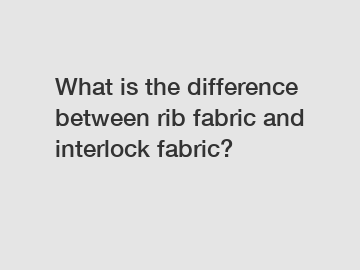Dec. 20, 2023
Textiles & Leather Products
What is the difference between rib fabric and interlock fabric? Rib fabric and interlock fabric are two common knitted fabrics used in the textile industry. Although they may appear similar at first glance, there are significant differences between the two that affect their appearance, stretchability, uses, and overall characteristics.
Rib fabric, often referred to as rib-knit, is a type of knit fabric characterized by its distinct vertical lines or ridges. These lines are formed by alternating raised and lowered rows of stitches, which create a ribbed texture. This fabric is known for its excellent stretchability and recovery, making it ideal for garments that require elasticity, such as cuffs, collars, and waistbands. The vertical ribs also give rib fabric a unique visual appeal, adding texture and depth to the fabric's surface.
In contrast, interlock fabric is a double-knit fabric created by interlocking two layers of fabric together. Unlike rib fabric, interlock fabric does not have distinct ridges or lines. Instead, it has a smooth and uniform surface on both sides, making it reversible. This fabric is known for its stability and durability. It has excellent shape retention and does not easily stretch out of shape, making it suitable for garments that require structure, such as T-shirts, dresses, and activewear.

The differences between rib fabric and interlock fabric stem from their manufacturing processes. Rib fabric is created by using a special type of knitting machine that has two sets of needles. One set of needles knits the fabric, while the other set knits the alternating raised and lowered rows, creating the ribbed texture. On the other hand, interlock fabric is created by knitting two layers of fabric together simultaneously, using a double-knit machine. This double-layer construction gives interlock fabric its stability and greater density compared to rib fabric.
The choice between rib fabric and interlock fabric depends on the desired characteristics of the final product. Rib fabric is preferred for garments that require stretch and elasticity, while interlock fabric is favored for garments that require stability and durability. The distinct appearance and texture of rib fabric make it suitable for creating accents and details on clothing, enhancing their visual appeal. Interlock fabric, with its smooth and reversible surface, is versatile and can be used for both casual and formal garments.
In conclusion, the difference between rib fabric and interlock fabric lies in their appearance, stretchability, uses, and manufacturing processes. While rib fabric has distinct vertical lines and excellent stretchability, interlock fabric offers a smooth and reversible surface with greater stability. Understanding these differences enables textile manufacturers and designers to select the appropriate fabric for their specific needs, resulting in high-quality garments with desired characteristics.
Contact us to discuss your requirements of is cotton fire resistant, yellow nylon fabric, Heat Resistant Fabric Suppliers. Our experienced sales team can help you identify the options that best suit your needs.
Previous: Should I get light or dark area rug?
Next: Bamboo Microfiber Fabric: Unlocking Affordable Comfort
If you are interested in sending in a Guest Blogger Submission,welcome to write for us!
All Comments ( 0 )